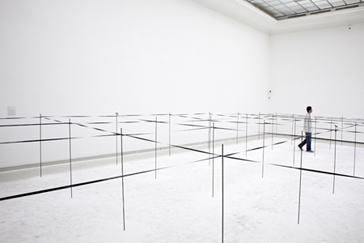
Mona Vatamanu was born in 1968 in Romania and Florin Tudor was born in 1974 in Switzerland

2010
Installation in situ
Dimensions variables
Year of Purchase: 2011
“- The realization of the work depends on the site, so the dimensions are variable.
- The floor must be white in order to protect the structure, and a false floor can be built.
- The artists wish to be present at the installation of the work.” 0
The installation Land distribution delimits in the exhibition space an “entangling” 1 ground, “net-like country,” 1 “which can be abandoned but is hard to re-occupy.” 1
This in situ intervention erects in the exhibition room a partition made of a system of reinforcing bars stuck in the ground and of lengths of VHS tape circumscribing enclosures that divide the space into a new cadastral grid framing the site. This property zoning appropriates the space of the exhibition in an exclusive and alienating manner. It makes it impossible to install or contemplate any other work, be it on the ground, in the air, or on the walls. This apparatus constrains the bodies of visitors to bend over as they pass through, unless they’re children.
In their artistic practice, Mona Vàtàmanu & Florin Tudor construct situations evocative of Situationism where art is considered to be a political instrument. It reflects the reality and displaces it in an aesthetic narration which functions subjectively as a connection between art and reality.
The artists question here the modern collapse of socialist utopias: and specifically, of the idea of land distribution, replaced by a return to exploitation, namely in the 1990s in Eastern Europe—Mona Vàtàmanu is Romanian—where collective property was taken over by private or public speculators and the world of finance. The land and access to it signify capital, the market, reform policies, poverty, or dispossession, depending on the geographic, historical, and sociopolitical conditions. Land becomes mere ground, and no longer a territory which governs a history of identity bound to a place. It becomes a loan, a transaction.
The place of exhibition is a public space. If the work resonates formally with Minimalism, it literally appropriates a practice of land redistribution performed by the Venezuelan Marxist dictatorship in order to allow the poorest people to have their own self-sufficient farms.
Land distribution organizes the creation of an analytical space whose material translation invites a contradictory interpretation: a dialectic of place (as a unit of residence) and territory (as a unit of domination). The VHS (Video Home System) “screen,” made from the obsolete magnetic tape technology, changes the very nature of legibility. Stories and images which have defined the last quarter of the twentieth century are gone with the medium, and in this material rehabilitation of the medium, they are able, after all, to look into the future. This economy of means borrowed from Venezuela is well suited to the definition of contemporary art as precarious, and contemporary because constantly in the process of becoming. The image emphasizes the fact that the emerging techniques and technologies are always destined to disappear, are condemned to being transitory, unlike the earth. “Property is theft,” 2 a form of original violence which brings about inequality and which must be questioned for the sake of the more vital culture, understood in all the senses of the word.
0 Mona Vàtàmanu & Florin Tudor, excerpt from instructions for Land distribution
1 “Sun Tzu said: We may distinguish six kinds of terrain, to wit: (1) Accessible ground; (2) entangling ground; (3) temporizing ground; (4) narrow passes; (5) precipitous heights; (6) positions at a great distance from the enemy.”, Sun Tzu, The Art of War, 4th century B.C.
2 Pierre-Joseph Proudhon, Qu’est-ce que la propriété ?, 1840
Luc Jeand’heur
www.monavatamanuflorintudor.ro